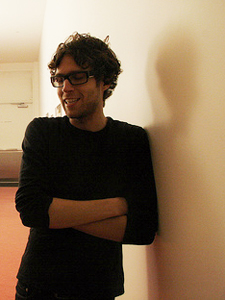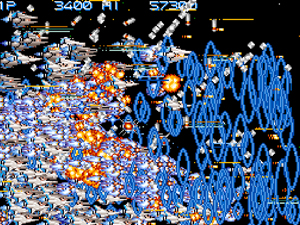Calit2 Visual Artists Display Work in MFA 2009 Exhibition
By Tiffany Fox, (858) 246-0353, tfox@ucsd.edu
San Diego, CA, June 12, 2009 —The University of California, San Diego's Kael Greco has lost his life a total of 333 times. When the kicks to the head didn't get him, the samurai swords did. Or the red-hot fireballs. Or the spiky claws of a giant, one-eyed prehistoric insect.
|
Ah, how an artist will suffer for his work (if one can call playing video games for hours on end "suffering").
"I'm really interested in permutations of possibilities," says Greco, whose 16-bit video game installations are featured at the University Art Gallery (UAG) in "MFA 2009", an exhibition of works by 13 artists selected from among UC San Diego students graduating this month with a Master of Fine Arts degree.
"With this project," he continues, "I wanted to look at the potential and possibility of interaction and play, to put all that data into one view and achieve a strange summation of everything that's possible in a video game."
Greco is one of two artists featured in the MFA 2009 exhibition who are affiliated with the California Institute for Telecommunications and Information Technology (Calit2). He has worked with Calit2 researcher Shannon Spanhake on the Squirrel wireless-enabled pollution sensing device, for which Greco wrote a mobile webcam application. The app continuously uploads images taken by a mobile phone and tags them with the data from pollution sampling.
|
Also selected to present in "MFA 2009": Calit2-affiliated researcher Micha Cardenas. Video and still photography are on display from her final MFA project, "Becoming Dragon", an immersive, virtual reality-based performance art work which had its first full-length performance simultaneously in Second Life and in the Center for Research in Computing and the Arts (CRCA) at Calit2.
The exhibition takes place through June 28 in the UAG, which is located in the Mandeville Center and is curated by Stephen Hepworth.
For his art work, Greco played the old-school video throwbacks "Gradius 3" and "Super Double Dragon" for "an embarrassingly long time," recording each play-through with software of his own creation. Sometimes he'd play the games normally; sometimes he'd try to achieve a certain aesthetic effect. When he'd died enough times (237 lives lost in Gradius 3 and 96 in SuperDoubleDragon) he remapped the data so it was spatially consistent, meaning that each game started off at the same point but simultaneously showed all the possibilities thereafter: A kick to the throat, a fatal blow to the head with nunchucks, a near-collision with a falling meteorite.
In "96 Lives" (which takes place along a casino-studded boulevard in Super Double Dragon world) the reprocessed end result resembles a digitized Guernica, a chaotic tangle of buff, angry-looking dudes beating one another to a pulp. In "237 Lives" (the Gradius 3 creation), dozens of spaceships fire missiles in all directions in an ever-expanding fractal of cosmic destruction. It's difficult to tell who's trying to kill whom, and that's precisely the point.
"I'm not trying to make a statement about violence," says Greco. "But with most video games, all you're doing is destroying things over and over in a senseless loop of destruction. They're all about punching someone or shooting someone or blowing something up. Once I saw that emerging as I played these games, I really wanted to play that out — make it big, make it loud, and make it grab you."
|
In his work for CRCA, Greco — who earned undergraduate degrees in computer science, mathematics and art from the University of Wisconsin, Madison — is developing a mobile phone application for a passive, multiplayer online game that constructs virtual worlds based on how one interacts with and moves through the social world.
Greco says he sees his "Lives" videos as "fun, visceral, easy-to-digest projects" that are more like a hobby than serious research. But he does plan to show them a few more times over the course of the next few months and expand upon the work during the fall quarter.
He adds: "To me, there's so much nostalgia embedded in these games. I've been fascinated by how much can be implied by these pixelated sprites telling a story or giving an impression. I guess my work shows my own fascination with really primitive graphics, these games that have been left behind and/or passed over for the past 20 years."
Media Contacts
Tiffany Fox, (858) 246-0353, tfox@ucsd.edu
Related Links




